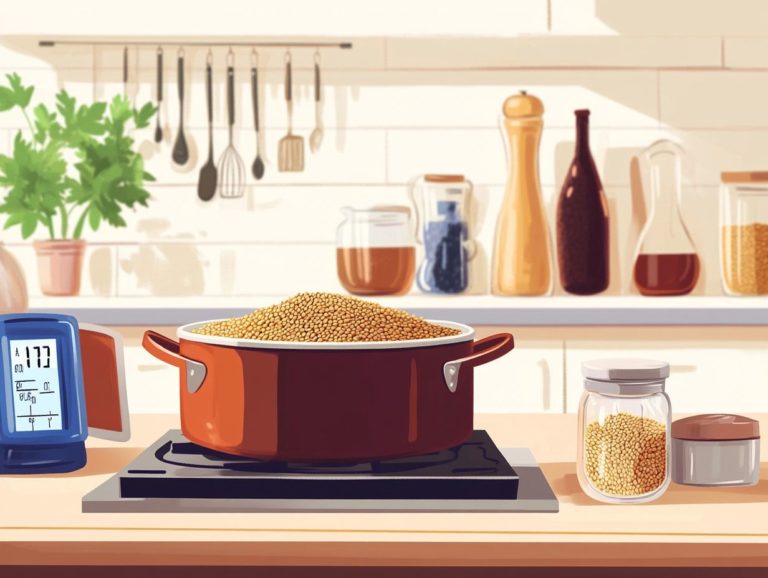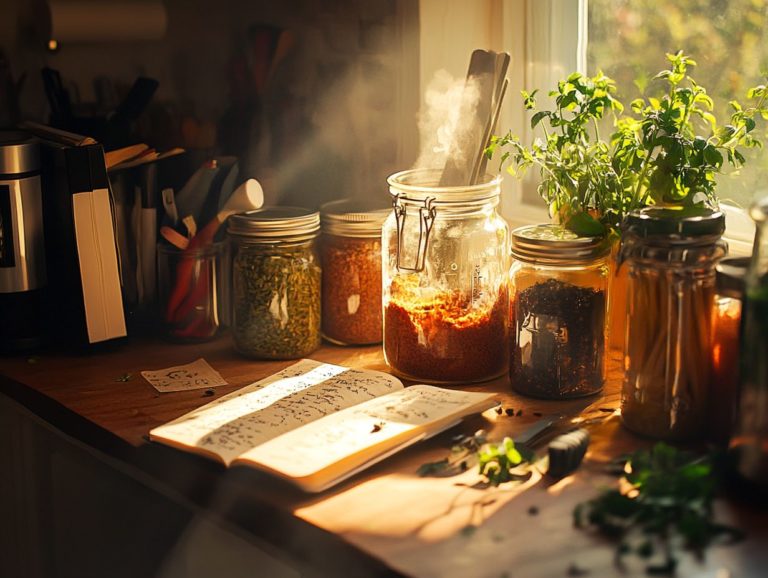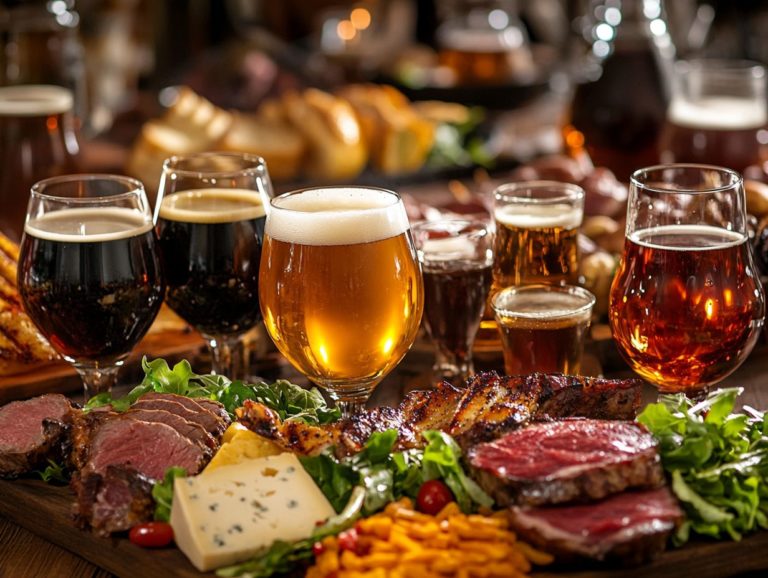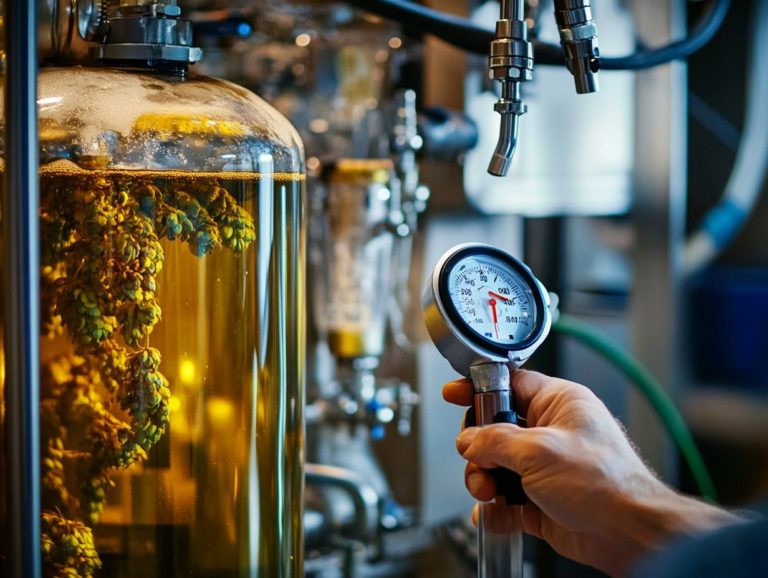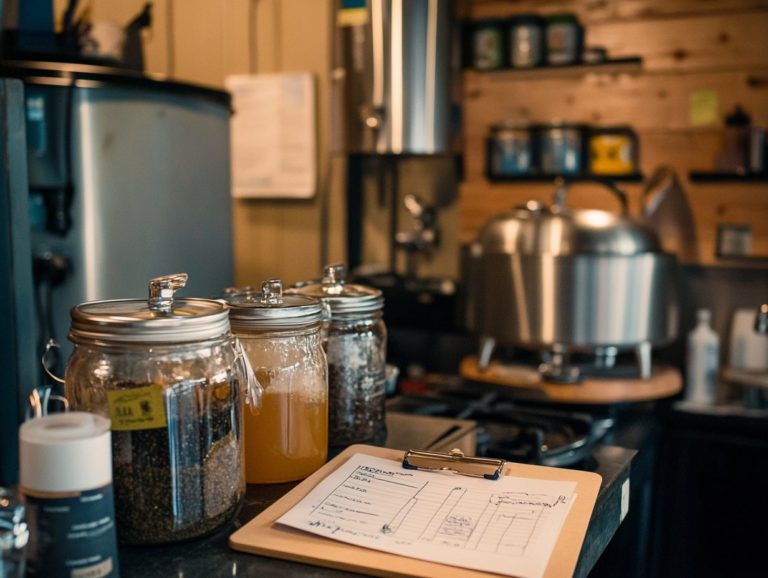Home Brewing Tips for Advanced Techniques
Contents
- Home Brewing Guide: Elevate Your Skills
- Mastering Advanced Home Brewing
- Advanced Home Brewing Techniques
- Troubleshooting Common Home Brewing Issues
- 1. Off-flavors in Beer
- 2. Infection Control
- 3. Carbonation Problems
- Tips for Experimenting with Home Brewing
- Frequently Asked Questions
- What are some advanced techniques for home brewing and improving homebrew quality?
- How can I make my home brewed beer more clear and improve its flavor aroma clarity?
- What is the best way to control the temperature during fermentation and manage fermentation pressure?
- Can I use different types of wood for barrel aging in various brewing styles?
- How long should I dry hop my beer for to achieve the desired flavor profiles?
- What are some tips for creating a yeast starter and ensuring essential yeast health?
Home Brewing Guide: Elevate Your Skills
Are you prepared to elevate your home brewing skills to new heights?
Whether you re just starting out or have years of brewing experience, this guide is packed with insights to take your skills to the next level. Whether you re a novice keen on mastering the fundamentals or an experienced brewer eager to delve into advanced techniques, this guide offers valuable insights for all levels.
From selecting top-quality ingredients and perfecting the fermentation process to troubleshooting common challenges and experimenting with distinctive flavors, every aspect will be addressed.
Join in to discover essential tips, advanced methods, and innovative ideas that will enhance your brewing expertise and enable you to make great beers at home.
Key Takeaways:
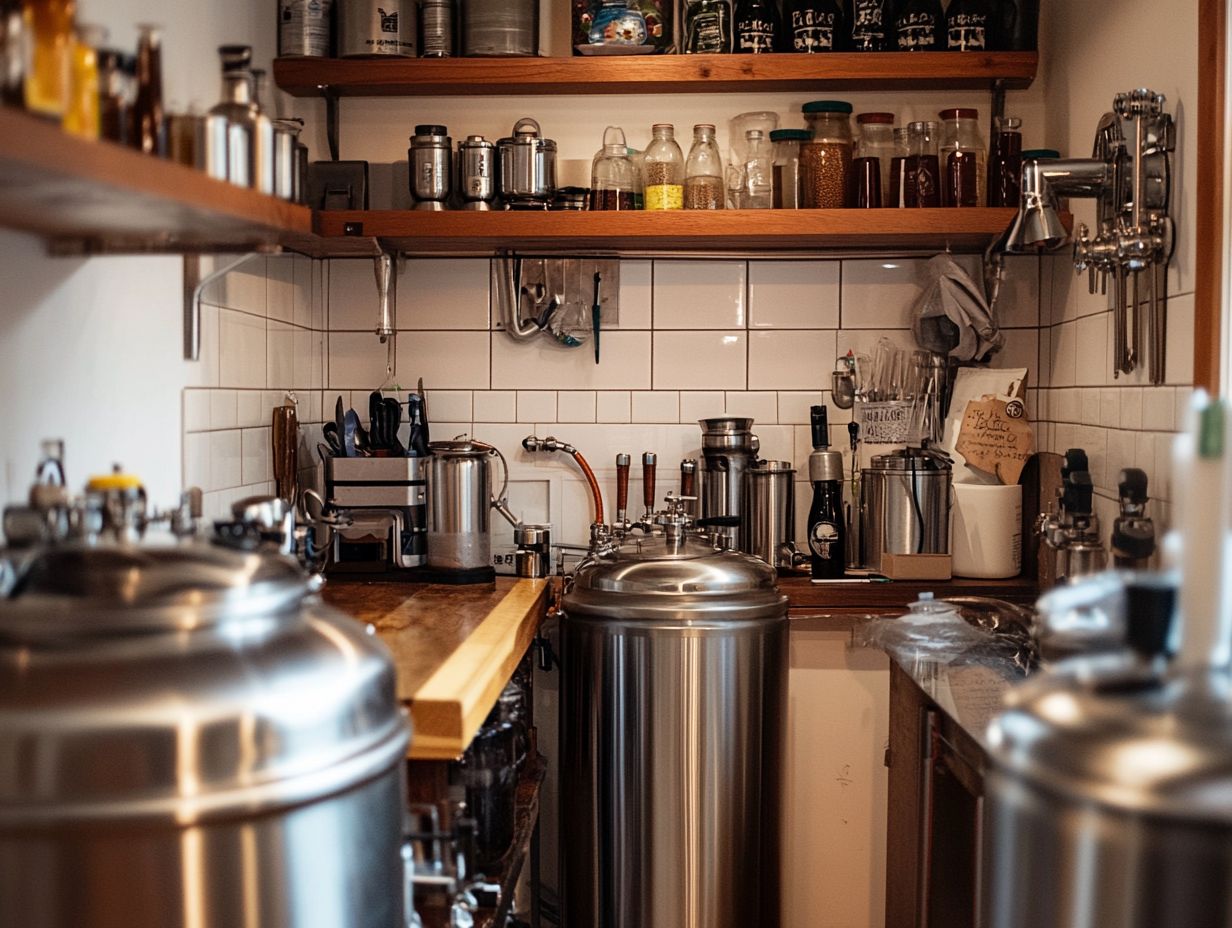
- Experiment with your brewing by collaborating with other brewers and trying different brewing methods.
- Troubleshoot common issues like off-flavors, infections, and carbonation problems to improve the quality of your homebrew by managing fermentation pressure and using an emergency brew kit for quick fixes.
- Take your home brewing to the next level with advanced techniques such as barrel aging, dry hopping, and kegging with carbonation.
Basic Home Brewing Techniques
Homebrewing is more than just a hobby; it’s a science that involves understanding the complete brewing process, from start to finish. Learn from brewing books and use simple measurements to streamline your brewing sessions.
Basic home brewing techniques are essential for anyone aspiring to craft exceptional beer in the comfort of their own home. Grasping the intricacies of the brewing process right from selecting the finest ingredients to perfecting fermentation plays a crucial role in achieving the optimal flavor, aroma, and clarity in your final brew. Your brewing knowledge will expand significantly as you master these techniques, leading to better homebrew quality.
Mastering these techniques will significantly enhance the quality of your homebrew, enabling you to explore a diverse array of beer styles, such as American Pale Ale. By utilizing advanced brewing technology and equipment, you will elevate your brewing journey, confidently navigating common brewing challenges with finesse.
1. Choosing the Right Ingredients
Choosing the right ingredients is absolutely fundamental to your home brewing journey, as they directly shape the flavor profiles and overall quality of your beer. This includes selecting the perfect brewing water that harmonizes with your recipe, the essential yeast strains that will effectively ferment your wort, and the hops that will impart the desired bitterness and aroma. Craft brewers know how important it is to manage water profiles, such as chloride sulfate ratios, and practice pH control to achieve the best results.
The selection process for these ingredients demands your careful attention to various factors. For instance, water chemistry is crucial because the minerals in your water can affect how well the ingredients work together. The mineral content can significantly influence pH levels, which in turn affects enzymatic activity during mashing.
In terms of hops, different varieties offer unique flavor characteristics and aroma qualities that can vary greatly depending on when they are introduced during the brewing process.
Your choice of yeast strain is paramount; it not only impacts alcohol tolerance and fermentation speed but also shapes the overall profile of your beer by producing specific esters (which can give beer fruity flavors) and phenols (which can add spicy or smoky notes) during fermentation. Mastering these selections ensures that your final product aligns perfectly with both your personal preferences and the established brewing standards.
Get ready to brew your best beer yet! Dive in and start experimenting today!
2. Sanitizing Equipment
Proper sanitation routines, including using a hop spider and acidified sparge, can prevent trub settlement and contamination.
Sanitizing your brewing equipment is a crucial step in the home brewing process. This ensures that you achieve sanitization success while preventing any issues with infection control that could spoil your hard work. It involves using effective methods to clean and sanitize all your brewing tools, including fermenters, kegging systems, and bottling equipment.
By following proper sanitization practices, you re safeguarding your investment in quality ingredients and technology. Consider using tools like a hop spider during the brewing process to reduce trub settlement.
Using different cleaning methods, such as no-rinse solutions or heat sterilization, is essential for maintaining a pristine brewing environment. These methods eliminate harmful bacteria and help preserve the distinct flavors that make your homebrew unique.
Choose brewing products that are specially designed to elevate your craft, like phosphoric acid or iodophor. These ensure thorough cleaning without leaving any unwanted residues. A sterile environment, combined with well-maintained equipment, creates the ideal conditions for fermentation and elevates the overall quality of your brew.
Investing the time in proper sanitization will undoubtedly pay off in the flavor and success of your finished product.
3. Boiling and Cooling the Wort
Using a wort chiller or a Spike Wort Chiller can drastically reduce cooling time and improve the clarity of your brew.
The boiling and cooling of wort are critical stages in your brewing process that significantly influence flavor, aroma, clarity, and overall beer quality. During this phase, utilizing a boiling kettle allows you to extract alpha acids from hops. Advanced techniques like dry hopping can elevate your beer’s flavor profile.
A wort chiller, such as a Spike Wort Chiller, is extremely effective in quickly and efficiently bringing down the wort temperature.
These elements are vital in shaping the final character of your brew, as different hop additions at various stages can lead to unique aromas and varying levels of bitterness. For example, adding hops late in the boil preserves more volatile compounds, resulting in brighter hop flavors.
The timing of these additions also plays a key role in the mouthfeel and aftertaste of your beer. Rapid cooling techniques, such as using a recirculating chiller, can prevent undesirable reactions and the development of off-flavors, ensuring a cleaner, crisper finish.
By meticulously managing these processes, you can craft unique and exceptional brews that truly stand out in a competitive market.
4. Fermentation Process
Understanding the fermentation process is key to managing pitching rates, reducing ABV, and increasing IBUs as per your recipe.
The fermentation process is where the real magic unfolds, transforming your wort into beer through the dynamic action of yeast. It s crucial to grasp the concept of pitching rates the amount of yeast you add as this knowledge is essential for successful fermentation.
Advanced techniques, like fermenting under pressure, can significantly boost the quality of the final product. By employing these techniques, you can enhance flavor profiles and minimize off-flavors.
Managing the yeast cake that settles at the bottom of the fermenter is vital for the success of future batches. This transformation typically spans several days, starting with the yeast pitch and culminating in the glorious moment when your beer is ready for bottling.
Various factors influence yeast behavior during this timeline, including temperature, the design of your fermentation vessel, and the original gravity of the wort.
If you encounter common issues like sluggish fermentation or surprising off-flavors, timing is crucial; don t let your hard work go to waste! Consider adjusting the oxygen levels at the outset and maintaining optimal temperature control throughout.
By keeping a close watch on these variables and using the latest fermentation technology, you can significantly boost yeast performance and achieve greater consistency in your brews.
Mastering Advanced Home Brewing
Advanced Home Brewing Techniques
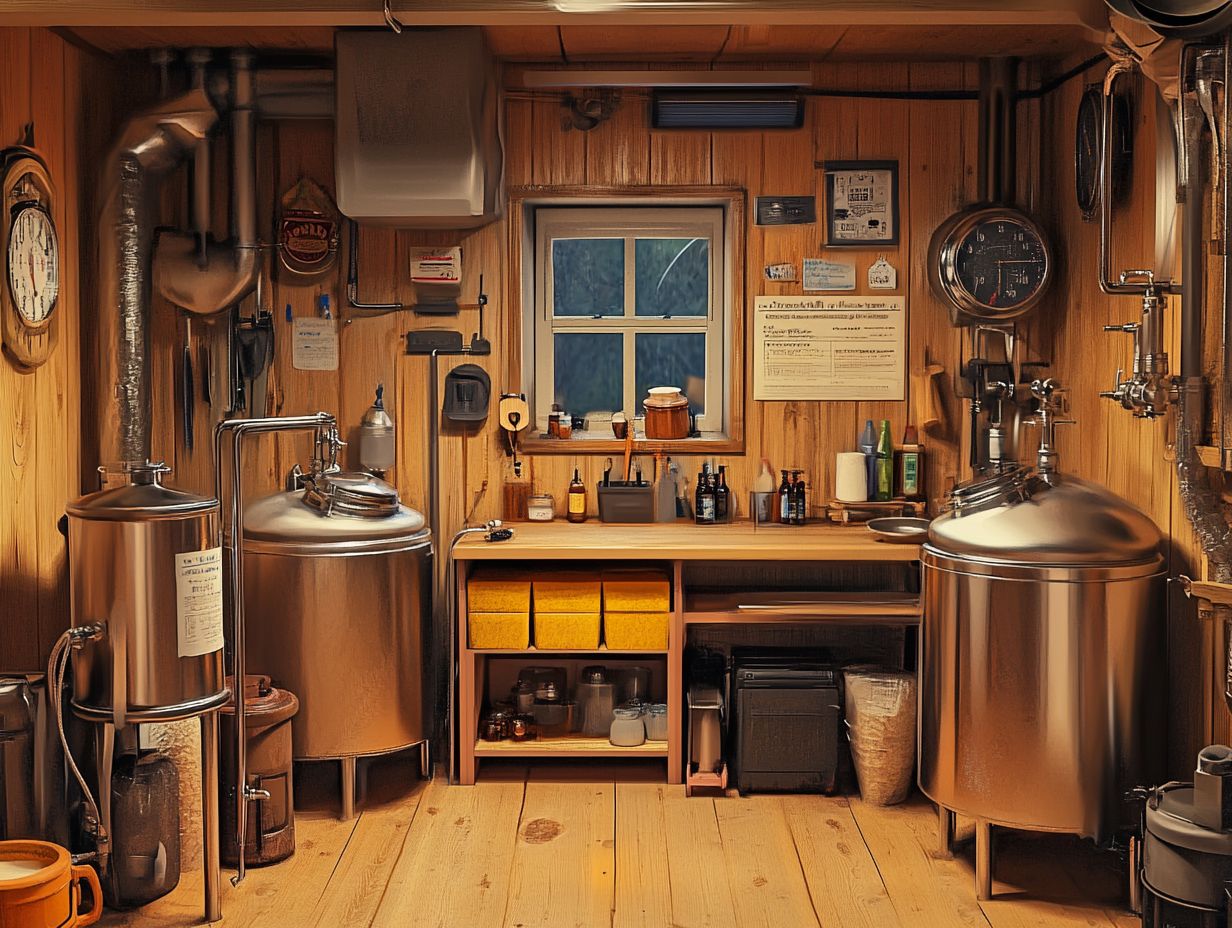
Advanced techniques such as decoction mashing, barrel aging, and using brite tanks can significantly impact the final results.
Advanced home brewing techniques provide you with the tools to elevate your craft and produce exceptional beers that meet the highest flavor standards. These methods push the boundaries of traditional brewing, integrating innovative brewing technology and high-gravity practices. By incorporating resources like a brewing library and consulting experts such as Gordon Strong or learning from award-winning brewers like Nate Lanier from Tree House Brewing, you can master these advanced skills.
By embracing these techniques, you can create complex flavor profiles and unique beer styles that rival even the finest commercial craft beers.
1. Dry Hopping
Advanced dry hopping techniques, such as using a dry hopping vessel, can add complexity to your beer’s flavor.
Dry hopping is an advanced technique that allows you to add hops during or after fermentation, enhancing the aroma and flavor without increasing bitterness. This method is particularly favored in styles like American Pale Ale, where that hop-forward character is essential to the beer’s identity.
Craft brewers often use dry hopping vessels to maximize the infusion of aromatic oils from different varieties of hops. You have several options for dry hopping: you can hop directly in the fermenter, use a hop bag, or even employ a dry hopping vessel to better infuse those aromatic oils.
Timing is everything. Adding hops at various stages of fermentation can produce a range of flavor profiles. For example, if you dry hop early in the fermentation process, you’ll promote a juicier character, while late additions closer to the end will maximize those aromatic qualities.
To achieve the best results, select the right hop varieties based on your desired flavors, manage oxygen levels effectively, and maintain a suitable temperature to preserve those delicate aroma compounds. When done right, dry hopping can significantly elevate the overall beer experience.
2. Kegging and Carbonation
Kegging your homebrew is an advanced and convenient method for packaging and carbonating your beer. It allows you to enjoy your creation without the tediousness of bottling.
It s essential to grasp the intricacies of kegging techniques and manage carbonation levels carefully to prevent common carbonation issues and ensure your beer delivers optimal flavor. Advanced techniques in kegging homebrew include regulating fermentation pressure and using a brite tank (a vessel used to clarify beer after fermentation) for secondary clarification.
As you embark on the kegging journey, take the time to familiarize yourself with pressure regulation. Improper settings can lead to either over-carbonation or, worse, flat beer.
You can also experiment with various carbonation methods, such as force carbonating or naturally carbonating, which can influence the final taste and mouthfeel of your brew. By monitoring fermentation pressure during this process, you ll help maintain the quality of your beer.
When unexpected issues arise, troubleshooting becomes your best friend. Keep detailed notes on temperature consistency and CO2 levels, as these insights will be invaluable for refining future batches and ultimately enhancing your kegging experience.
Start implementing these techniques today and take your home brewing to new heights!
3. Barrel Aging
Barrel aging is an intricate technique that transforms craft beer. It allows the beer to mature in previously used barrels, infusing it with unique flavors. This process elevates flavor profiles, turning each batch into a distinct expression of your creativity as a brewer.
Utilizing advanced techniques, such as pH control and optimizing the brewing water profile, can further enhance the aging process. The choice of barrels be it oak, bourbon, or rum casks can profoundly influence the beer’s character. Each type brings its own distinct notes, adding layers of complexity, such as vanilla, caramel, or even a hint of spice.
Properly managing chloride sulfate levels can also play a critical role in defining the final taste. The aging timeline is not a one-size-fits-all; some brews may only need a few months, while others might require years to reach their full potential.
As the beer interacts with the wood, fascinating chemical reactions occur. These include oxidation, which is when the beer reacts with oxygen, and the extraction of tannins, which are compounds that add flavor and astringency. These processes enrich the flavor profile and aroma. Incorporating DIY measurements can help you monitor these changes effectively.
The subtle nuances introduced during this aging process culminate in a truly distinctive craft beer experience. This delights enthusiasts and showcases your skillful mastery of the brewing art.
4. Souring Techniques
Dive into the exciting world of souring techniques to create beers that wow your friends! Souring techniques involve intentional fermentation with wild yeast and bacteria. This results in tart and complex flavor profiles that are increasingly celebrated in the craft beer scene.
By mastering these techniques, you’ll tackle various brewing challenges and craft distinctive sour beers that stand out. Advanced brewing skills and a well-equipped brewing library can be invaluable for your journey.
To achieve these remarkable flavors, you ll often find yourself experimenting with different strains of Lactobacillus and Brettanomyces. Be sure to meticulously control the fermentation environment. The souring process can typically span from a few days to several months, depending on the specific flavors you aim to create and the methods you employ.
It s essential to remain vigilant about potential pitfalls. Unintended off-flavors from wild yeast contamination or improper sanitation could easily derail your entire batch. Utilizing an emergency brew kit can help you quickly address these issues when they arise.
Successful souring not only enhances your brewing repertoire but also enriches the overall tasting experience. It showcases the intricate dance of flavors that can emerge from the fermentation process. Properly managing your brewing water and understanding its impact on fermentation can lead to more consistent results.
Troubleshooting Common Home Brewing Issues
Troubleshooting common home brewing issues is crucial for anyone striving for consistency and quality in their beer. By identifying off-flavors, tackling infection control, and resolving carbonation problems, you can gain a deeper understanding of these challenges.
Acting on this knowledge can transform your brewing game today! It enables you to refine your techniques and ultimately elevate the quality of your final product. Utilizing brewing tips from industry experts such as Gordon Strong and Nate Lanier can further enhance your brewing process.
1. Off-flavors in Beer
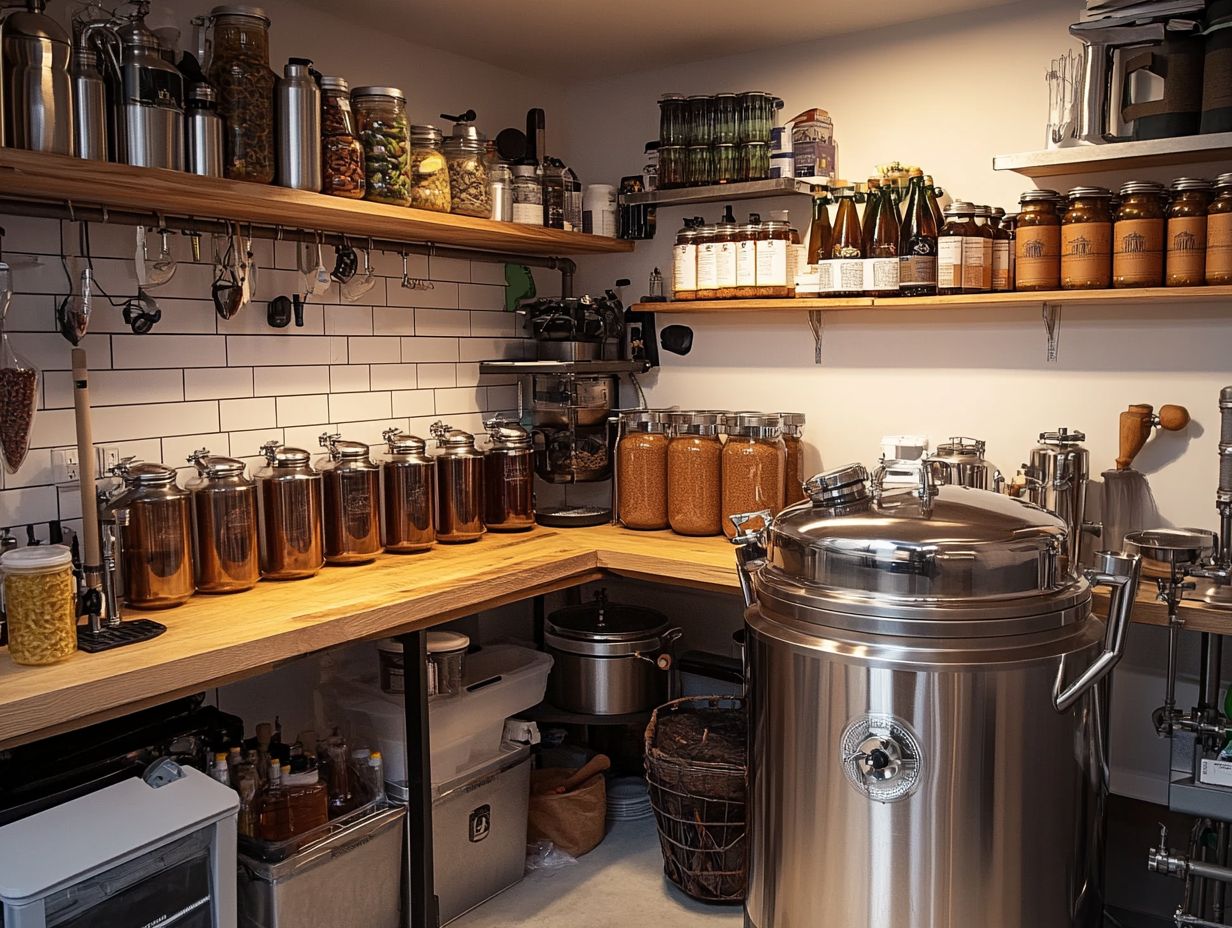
Identifying and addressing off-flavors in beer is essential for you as a brewer if you want to create a clean and enjoyable drinking experience. These off-flavors can stem from various brewing techniques and fermentation issues, significantly affecting the quality and drinkability of your beer.
Understanding the common causes behind these undesirable flavors can provide you with invaluable insights, whether you’re a novice or a seasoned brewer. For instance, unwanted aromas like diacetyl and acetaldehyde often arise from inadequate yeast management or fluctuations in fermentation temperature. Oxidation can introduce stale or cardboard-like flavors, while infections may bring in sour or funky notes.
Enhancing your brewing knowledge through resources like “Brewing Better Beer” by Gordon Strong can be extremely beneficial.
By closely monitoring fermentation conditions and maintaining strict sanitation practices, you can significantly reduce the chances of these off-flavors cropping up. Selecting high-quality ingredients is also crucial for your success.
Ultimately, being proactive and knowledgeable about these challenges sets you on a path to crafting superior brews that will truly satisfy any palate.
2. Infection Control
Infection control is essential in your brewing process to protect the quality and safety of your beer from unwanted microorganisms. By implementing proven sanitization strategies and best practices, you can maintain a pristine brewing environment.
Understanding the most common sources of infection is key. These can include contaminated brewing equipment, unfiltered water sources, and even airborne contaminants that may invade during fermentation.
To tackle these potential threats, adopt effective sanitization methods. This means thoroughly cleaning all utensils and fermenters with heat or chemical agents specifically designed for brewing.
Regularly monitoring for signs of infection is vital. If you spot any indication of infection, it s crucial to take immediate action to resolve the issue. This not only safeguards the final product but also preserves the quality of your beer and your reputation as a brewer.
Effective use of a wort chiller and maintaining trub settlement can also aid in preventing infections.
3. Carbonation Problems
Carbonation problems can greatly influence the flavor and mouthfeel of your beer, so grasping how to achieve the ideal level of carbonation is paramount. Whether you re kegging your homebrew or opting for the bottling route, effectively managing fermentation pressure and carbonation methods is essential for meeting your flavor standards.
In the kegging process, you might encounter common carbonation issues that arise from improper temperature control, excessive agitation, or fluctuating CO2 levels. If your beer isn t cold enough, it may struggle to absorb adequate gas, resulting in a flat brew. On the flip side, over-carbonation can rear its head from high serving pressures.
To tackle these challenges, it s crucial for you to keep a close eye on your keg s temperature and utilize a precise CO2 chart for adjustments. A gentle touch when handling the keg will also help maintain stable carbonation.
Techniques like spunding (a method for controlling fermentation pressure) or incorporating priming sugars during fermentation can further ensure you achieve optimal levels.
And remember, patience is key; sometimes allowing your beer to naturally carbonate over time can lead to the most rewarding results. Understanding the nuances of fermenting under pressure can also provide better control over the carbonation process.
Tips for Experimenting with Home Brewing
Experimenting with home brewing is an exciting chance to unleash your creativity! It allows you to elevate your brewing hobby and refine your skills, enabling you to craft distinctive and personalized flavor profiles.
By integrating new ingredients and techniques, as well as collaborating with fellow brewers, you can consistently enhance your recipes and cultivate your advanced brewing expertise.
Using a hop spider can help manage hop additions during the boil, ensuring a clearer end product.
1. Using Different Yeast Strains
Using different yeast strains can significantly transform the flavor profiles of your beer. Each strain brings its unique characteristics to the fermentation process, allowing you to craft an impressive array of flavors and aromas. Experimenting with essential yeast varieties can lead to everything from fruity esters to spicy phenols.
Choosing the right yeast strain is essential and should be tailored to the beer style you aim to achieve. For example, lager yeast typically delivers a clean and crisp finish, while ale yeast enhances fruity notes, making it a fantastic choice for IPAs and American pale ales.
You might also consider Belgian yeast, celebrated for its complex and often spicy characteristics. This yeast is perfect for creating saisons or other Belgian ales. Gaining a solid understanding of the temperature ranges and fermentation profiles of these strains can further refine your beer s flavor. This ensures the final product aligns beautifully with your brewing intentions.
Ultimately, the secret lies in harmonizing the yeast’s behavior with the overall brewing process. This approach allows you to unlock the full potential of your chosen recipe.
2. Adding Fruits and Spices
Dive into the world of flavors! Adding fruits and spices will dramatically elevate your beer. This technique introduces exciting and unexpected flavor profiles, inviting creativity and experimentation in the craft beer world.
Choosing the right ingredients enhances your beer experience. For instance, citrus fruits like oranges and lemons can impart a zesty brightness, while tropical fruits such as mango and passionfruit offer a lush sweetness that beautifully balances out bitterness.
Similarly, spices like coriander and ginger can infuse warmth and depth, shaping the beer’s aroma and taste. As a craft brewer, consider the timing of these additions; incorporating them during fermentation can yield different results compared to adding them during the boil.
Ultimately, the successful integration of fruits and spices relies on a keen understanding of their flavor profiles and how they harmonize with the base malt and hops. Why not try adding some fruits and spices in your next brew?
3. Innovative Brewing Techniques to Enhance Flavor
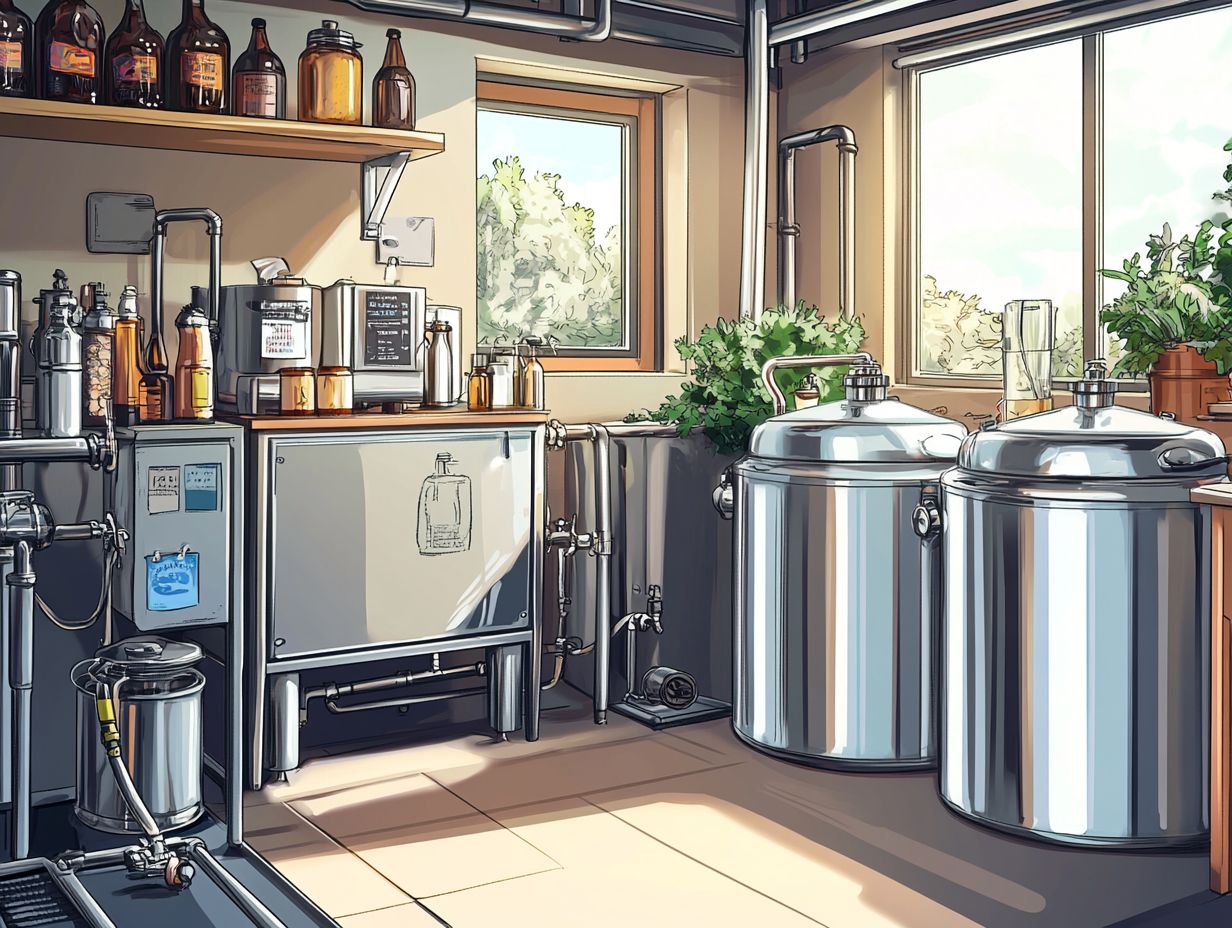
Exploring different brewing methods can elevate your beer-making journey. Techniques such as decoction mashing a method that involves boiling a portion of the mash to enhance flavor or high-gravity brewing can lead to remarkable flavor profiles and take your brewing skills to the next level.
Each method you try offers its own set of nuances. For example, experimenting with cold brew or nitro infusions can create a smooth, creamy texture that sets your brew apart from traditional methods. Understanding key factors like mash temperature, pH control, and hop additions allows you to fine-tune the sweetness and bitterness. It also shapes the aroma and mouthfeel of your final product.
Techniques such as barrel aging and decoction mashing can introduce complex layers of flavor. Enjoy delightful notes ranging from vanilla to oak! Simpler methods, like steeping grains and using acidified sparge water, can yield lighter, more approachable beers.
By diving into these diverse techniques, including learning about the balance of chloride and sulfate ratios in water, you can craft exceptional brews that showcase your creativity while honoring the rich tapestry of brewing traditions. So why not experiment with these techniques in your next brewing session?
4. Collaborating with Other Craft Brewers
Collaborating with other brewers is an enriching experience that can significantly elevate your brewing hobby, offering invaluable opportunities to exchange techniques and expand your brewing knowledge. By working alongside fellow brewers, including those from renowned breweries like Tree House Brewing, you can learn from each other, experiment with fresh ideas, and create unique brews that showcase your collective creativity.
This collaborative spirit not only cultivates a sense of community but also establishes a foundation for innovative practices, such as using a hop spider, that enhance brewing skills. Engaging with fellow enthusiasts can be as straightforward as joining local brewing clubs, participating in competitions, or attending workshops that emphasize teamwork and shared learning.
By connecting with others in the industry, you gain access to a wealth of diverse perspectives and innovations that can refine your craft. These interactions often lead to a delightful cross-pollination of ideas, inspiring you to push boundaries and explore unconventional brewing methods, such as fermenting under pressure or using a recirculating chiller, ultimately elevating the quality and variety of your products.
Frequently Asked Questions
What are some advanced techniques for home brewing and improving homebrew quality?
Some advanced techniques for home brewing include using a yeast starter, dry hopping, decoction mashing, and barrel aging to improve homebrew quality.
How can I make my home brewed beer more clear and improve its flavor aroma clarity?
To make your beer more clear and improve its flavor aroma clarity, you can use finings, cold crashing, and/or filtering. These techniques help to remove yeast and other particles from the beer.
What is the best way to control the temperature during fermentation and manage fermentation pressure?
The best way to control temperature during fermentation and manage fermentation pressure is by using a temperature-controlled fermentation chamber or a heat wrap with a temperature controller. This will ensure that your beer ferments at the optimal temperature for the yeast strain you are using.
Can I use different types of wood for barrel aging in various brewing styles?
Yes, you can use different types of wood for barrel aging. Some popular choices include oak, cherry, and maple. Each type of wood will impart different flavors and aromas to the beer, making them suitable for various brewing styles.
How long should I dry hop my beer for to achieve the desired flavor profiles?
The length of dry hopping can vary depending on personal preference and the style of beer being brewed. Generally, 3-5 days is a good amount of time for dry hopping. However, some brewers prefer to dry hop for longer periods of time to achieve a more intense hop aroma and desired flavor profiles.
What are some tips for creating a yeast starter and ensuring essential yeast health?
To create a yeast starter, it is important to use a sterilized container and to use a yeast nutrient to promote healthy yeast growth. Ensuring essential yeast health, it is also recommended to oxygenate the starter wort and to use a stir plate to keep the yeast in suspension and promote a healthy colony.

